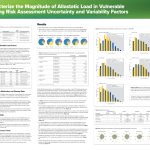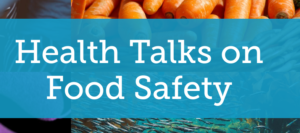EpidStrategies, a division of ToxStrategies LLC, is excited to announce that Mina Suh, Naimisha Movva, Xiaohui Jiang, Sue Pastula, and Heidi Reichert, along… read more
Author Archives: cmccormick
ToxStrategies research into quantifying non-chemical stress in cumulative impact assessment for Environmental Justice communities
ToxStrategies named recipient of Research Grant to Conduct a Systematic Literature Review
ToxStrategies is Presenting and Exhibiting at SOT 2023
ToxStrategies is excited to be returning to present and exhibit at The Society of Toxicology’s Annual Meeting, March 19th through March 23rd. The meeting is in Nashville, TN, at the Music City Center
Come by and see us at Booth #628!
Poster Presentations
- A Tiered Approach for Assessing the Safety of Polymeric Ingredients in Cosmetics and Personal Care Products; L. Brown, D.A. McMillan, J.D. Urban, and A.L. Mihalchik
- Reliability Assessment of Guideline-Based Studies Using Systematic Review Critical Appraisal Tools; N.Y. Choksi, S. Fitch, M.A. Harris, C.M. Thompson, and D.S. Wikoff
- Using NHANES Data to Characterize the Magnitude of Allostatic Load in Vulnerable Communities: Impact to Existing Risk Assessment Uncertainty/Variability Factors; A. East, W. Rish, and W.D. Klaren
- Development of a Study Quality Tool for Use in a Systematic Review of Literature Reporting Microplastic Exposure and Reproductive and Developmental Toxicity; S. Fitch, J. Rogers, S. Marty1, R. Ellis-Hutchings1, R. Becker2, and D. Wikoff; 1 Dow Chemical Company, Midland, MI; 2 American Chemistry Council, Washington, DC
- Risk Assessment of Three Smoke Flavoring Primary Products Currently Under Re-Evaluation by EFSA; A.C. Franzen, C.M. Thompson, G.P. Brorby, D.S. Wikoff, Z. Ilkbahar1, C. Doepker; 1 Kerry Inc., Naas, Ireland
- Updated Mode of Action Information Informing the Risk Assessment of HFPO-DA (GenX); L.C. Haws, M.M. Heintz, and C.M. Thompson
- Assessment of the Mode of Action Underlying Development of Liver Lesions in Mice Following Oral Exposure to HFPO-DA (GenX) and Relevance to Humans; M.M. Heintz, L.C. Haws, and C.M. Thompson
- In Vitro Transcriptomic Analyses Informing the Mode of Action of HFPO-DA (GenX) in the Liver; W.D. Klaren, M.M. Heintz, A.W. East, C.M. Thompson, and L.C. Haws
- Weight-of-Evidence Evaluation of Endocrine Activity for Di-Isodecyl Phthalate (DIDP) and Di-Isononyl Phthalate (DINP); I.A. Lea, M.M. Heintz, D. Feifarek, L.C. Haws, and S.J. Borghoff
- Toward Best Practices for Read-Across in Evaluation of Drug Impurities, Extractable, and Leachable Compounds; A.L. Mihalchik, N.Y. Choksi, and M.L. Wood
- Relative Oral Bioavailability of Manganese in Electric Arc Furnace Steel Slag is Influenced by High Iron Content and Low Bioaccessibility; D.M. Proctor, S. Vivanco, and A. Blanchette
- The Influences of Household Behavior, Environmental, and Demographic Factors on Indoor and Outdoor Air Quality; B.N. Rivera, L. Bramer1, C.C. Ghetu2, D. Rohlman3, K. Adams2, K. Waters1, and K.A. Anderson2; 1 – Pacific Northwest National Laboratory, Biological Sciences Division, Richland, WA; 2 – Department of Environmental and Molecular Toxicology, Oregon State University, Corvallis, OR; 3 – College of Public Health and Human Sciences, Oregon State University, Corvallis OR
- Scoping Review of the Immunomodulatory Effects of Cannabidiol: Effects within T cells; B.N. Rivera, A. Svetlik1, W.D. Klaren, D.S. Wikoff, and R.G. Henderson; 1 – Texas A&M University, College Station, TX
- An Evaluation of Risk Assessments on Hexavalent Chromium [Cr(VI)]: The Past, Present, and Future of Mode of Action Research; C.M. Thompson, D.S. Wikoff, D.M. Proctor, and M.A. Harris
Continuing Education
- Tailoring Off-the-Shelf Systematic Review Methods to the Identification and Evaluation of Mechanistic Data, Dr. Daniele Wikoff, Sunday, March 19th, 8:15 AM, Music City Center, Room 202
Exhibitor Hosted Session
- Modern Strategies to Evaluate Drug Impurities, Drs. Amy L. Mihalchik, DABT, R.A.C., Neepa Y. Choksi, Isabel Lea, and Marcie L. Wood, Monday, March 20th, 12:00 PM, Music City Center, Room 101A.
- Evaluation of drug impurities is a critical, occasionally overlooked aspect of drug safety. ToxStrategies consultants will present case studies of strategies and tools used to address safety of impurities present in prescription and non-prescription drugs, including targeted literature searches, read-across, and QSAR approaches.
- Participants will learn essential strategies to evaluate impurities in prescription and non-prescription drugs, and overall considerations to effectively support the safety of data-rich and data-poor impurities, including criteria for valid read-across rationales and integration of QSAR methods in drug impurity safety assessment.
Workshop and Symposium Sessions
- Continuing Towards Best Practices in Organizing, Assessing, and Applying Mechanistic Data in Hazard Characterization and Risk Assessment, Dr. Daniele Wikoff, Tuesday, March 21st, 8:00 AM, Music City Center, Karl Dean Ballroom
- Placental Biology, Toxicology, and In Vitro Modeling for Predictive Developmental Toxicology, Dr. John M. Rogers, Tuesday, March 21st, 1:00 PM, Music City Center, Karl Dean Ballroom
- Refining Inhalation Risk Assessments by Integrating New Approach Methodologies, Dr. William D. Klaren, Thursday, March 23rd, 8:30 AM, Music City Center, Room 207B
Educational-Career Development Session
- A Day in the Life of an Industry Toxicologist, Dr. Allison Franzen, Wednesday, March 22nd, 11:00 AM, Music City Center, Room 202
For a complete agenda of sessions and presentations click here.
ToxStrategies at the forefront: Environmental justice and cumulative impact assessment
EPA recognizes that there are environmentally related health inequities in certain communities, exacerbated by socioeconomic and psychological stressors, background health conditions, and ethnicity-specific… read more
WHO Panel Discusses Food Fraud and Food Defense
ToxStrategies senior consultant and food defense expert Dr. Jennifer van de Ligt joined a specialized panel to discuss food fraud and defense as a part of the World Health Organization’s (WHO’s) Health Talks series. Intentional adulteration of food affects consumers globally—it’s estimated that about 10% of a typical consumer’s purchased food is affected. Food defense strives to protect the food supply, whether the adulteration was intended to harm people or not. Food fraud, the most common form of intentional adulteration, is financially motivated, especially in times of rising food prices, and may cause human health harm. In addition, the public is increasingly wary of the potential for intentional adulteration specifically intended to cause wide-scale public health harm. This virtual Health Talk, presented on June 9, 2022, reflected current food fraud and defense considerations from industry, academia, and policy makers on development and implementation of food safety and defense measures.
In addition to her consulting work with ToxStrategies, Dr. van de Ligt is the former director of the Food Protection and Defense Institute and a professor at the University of Minnesota. She was joined on the WHO panel by Captain Jon Woody (FDA), Professor Tim Lang (Centre for Food Policy, University of London), and Dr. Annie Locas (Canadian Food Inspection Agency). Registrants can replay the recorded presentation here.
Article Discusses Uses of CDC’s National Report on Human Exposure to Environmental Chemicals in Risk Assessments
ToxStrategies scientists Ann Verwiel, LeeAnn Racz, Liz Mittal, and William Rish have published an article titled, “CDC’s National Report on Human Exposure to Environmental Chemicals” in SETAC Globe, the organization’s monthly newsletter. The CDC’s report provides statistical summaries of biomonitoring data collected as part of the National Health and Nutrition Examination Survey (NHANES). The authors provide examples of how various risk assessors have used the NHANES data to better understand whether their study population experiences exposures that are different from those of the U.S. general population, or to evaluate how chemical exposures have changed over time. The article indicates that the descriptive statistics now provided by CDC are readily available and sufficient to compare to exposures in a specific population, such as communities with environmental justice concerns. The national data in the CDC Report can be used as a benchmark for local community data or to assess national exposures among minorities and children, who may be more vulnerable to chemical stressors or cumulative impacts from multiple stressors.




